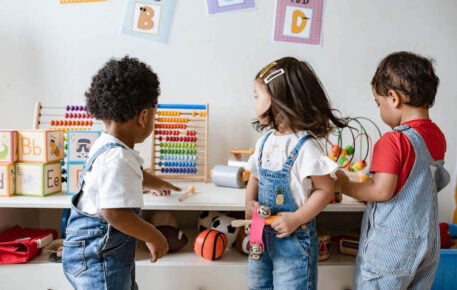We may think Christmas is the “most wonderful time of the year”, but our planet might disagree. While we enjoy our festivities, we use huge amounts of energy and create a lot of waste, putting our planet under increasing strain.
With climate change an increasingly important concern, even small changes to our Christmas celebrations can make a big difference to the environment.
Find out how you can make your Christmas more eco-friendly and reduce your carbon footprint, while still enjoying the festive period!
Choosing a sustainable Christmas tree
Brits buy between six and ten million real Christmas trees each year, but are they the most sustainable option?
In most cases, natural trees will be more eco-friendly than fake trees. However, it depends on a number of factors, including the tree’s origins, whether you have a cut or potted tree, how often you plan to use it, and how you will dispose of it.
For example, a real tree bought from a local seller will be more eco-friendly than a real tree imported from abroad that has clocked up thousands of miles in emissions.
If you buy a natural tree, you can check that it’s certified by the Forest Stewardship Council (FSC), which shows the tree has been grown in a sustainable and environmentally friendly way.
What you do with your tree once Christmas is over can also affect the environment. If you put it into landfill, it can produce a carbon footprint of up to 16kg of CO2. If, however, the tree is replanted, burnt on a bonfire or chipped, it may only have a carbon footprint of up to 3.5kg of CO2.
Another option is to recycle your Christmas tree. You may be able to put it with your garden waste bin on your collection day or take it to a local collection point. Check your local authority website to find out your options. Alternatively, there are also charities and other organisations that will collect and recycle your trees instead.
You could also consider renting a Christmas tree. There are a number of organisations that will allow you to rent a real tree for the festive period, and then take it back in January to replant it ready for next year.
Two-metre-high plastic trees can have a carbon footprint of up to 40kg of CO2, which is considerably more than a real tree. A lot of energy is often used to make the tree and, if you don’t reuse it, there’s the problem of plastic waste. The figures above indicate you have to reuse a fake tree for at least ten years for its carbon footprint to be comparable with a natural tree (that’s disposed of carefully).
If you already own an artificial tree, it will be more eco-friendly to continue using it for as long as possible, rather than getting a new tree.
Advantages and disadvantages of natural trees
| Advantages | Disadvantages |
|---|---|
|
|
|
|
|
|
| |
|
Advantages and disadvantages of artificial trees
| Advantages | Disadvantages |
|---|---|
|
|
|
|
Cut down your energy use
Christmas, and winter in general, is a time when most of us will use more energy. Over the festive period we are likely to use more electricity and have the heating on for longer, which is bad for the environment as well as our bank accounts.
With the rising cost of energy, these tips to help you cut down on your energy usage at Christmas will benefit your finances as well as the planet.
- Switch off lights and appliances when they’re not being used.
- Plan your cooking so you minimise the time the oven and hobs are switched on.
- Think of activities that don’t need as much electricity, such as playing board games instead of watching TV.
- Wear a Christmas jumper and cosy socks so you don’t need to use as much heating.
- Put draught-excluders at the bottom of doors and around windows to keep the heat in.
» MORE: How to save money at Christmas
Eco-friendly Christmas lights
Twinkling fairy lights, fluorescent Santas and outdoor light displays all contribute to the special Christmas atmosphere. But should we pause to consider the massive amount of energy that is used by our festive displays?
The answer appears to be a resounding yes. According to data from ElectricalDirect, we use 402,144,104 kWh of electricity on Christmas Day, which is enough to light up the Eiffel Tower for 50 years!
Here are some practical tips on how to reduce the energy consumption of your Christmas lights.
- Choose LED lights over halogen – they consume 80% less energy and last five times longer.
- Store your lights carefully so you don’t need to replace broken light bulbs.
- Put your lights on a timer so you don’t leave them on for extended periods.
- Use solar-powered lights or other renewable energy sources.
- Choose lights powered by a rechargeable battery (batteries are full of toxic chemicals, and are not recyclable, meaning they’re sent to landfill).
Meat-free Christmas
For many, a traditional Christmas dinner is the highlight of the day. It might include roast turkey, beef, pork, or chicken, with pigs in blankets, roast potatoes and all the trimmings, but is this meat-based feast damaging the environment?
From intensified farming to the transport of produce, the Christmas season puts strain on the environment, causing carbon emissions to skyrocket.
A study from Oxford University showed that switching from a meat-based diet to a plant-based diet could cut down on food emissions by up to 73%. However, this depends on where your meat and dairy products are sourced from, as local produce is likely to have a smaller carbon footprint than intensively-farmed imports.
Similarly, vegetarian and vegan options will differ when it comes to their impact on the environment, with some causing more damage than others.
However, experts agree that reducing your meat intake will generally be beneficial to the planet.
According to a report in 2018 by Humane Society International UK, a vegan Christmas dinner generates less than half of the carbon emissions generated by a meat dinner. This figure will vary depending on the kind of meat you choose and how much you eat, and what food you replace it with, but meat will typically have a bigger carbon footprint than many vegetarian or vegan alternatives.
Of course, it’s a big commitment to go entirely vegan or vegetarian for Christmas dinner, and some vegan options can be expensive, but there are several ways you can reduce the footprint of your meal.
- Choose organic, free-range, or sustainably-farmed products.
- Try to buy food that’s in-season and produced locally.
- If you still want to eat meat, chicken and turkey typically have a lower carbon footprint than a lot of other meats. Beef has one of the biggest carbon footprints, with one kilogram of beef generating 70kg of carbon emissions.
- Only buy food that you’ll definitely eat to avoid excessive waste.
- Find ways to reuse any leftovers, rather than throwing them away.
- Try to choose vegetarian or vegan options and minimise your meat intake.
- Don’t wrap or cover leftovers in cling film. Use beeswax wraps or other sustainable alternatives instead.
Eco-friendly Christmas gifts
According to a study by Oxfam, 31% of people are planning to buy secondhand gifts this year. While this is a promising figure, it still indicates that the majority of people will shun used gifts in favour of brand-new ones.
However, 42% of people also said they were more open to receiving secondhand presents this year than previously, which should encourage people to shop for pre-owned gifts.
When you buy gifts for friends and family, there are lots of environmentally friendly options you could consider. Instead of ordering a brand-new device or plastic toy that may be imported from abroad, why not buy from local sellers or choose secondhand goods and items made from sustainable materials.
Before buying a present, think about where the item is from and what it’s made of, as well as whether the person you’re giving it to will actually use it.
Most of us will have received a Christmas present that we didn’t really want and we may have thrown it away. This creates a huge amount of unnecessary waste so, even if your gift is locally sourced and sustainable, if it ends up in landfill it won’t help the environment.
Instead of throwing away any unwanted gifts, you can give them away or sell them so they can be reused.
» MORE: What to do with unwanted presents
Below are some tips to help you be more eco-friendly with your Christmas gifts:
- Buy gifts that are made and sold locally.
- Buy an activity or experience rather than a physical gift.
- Send a gift card or cash instead.
- Look at secondhand clothes, toys, and items in charity shops or online sellers.
- Choose ethically produced cosmetics and toiletries.
- Don’t buy plastic or electronic items, try to choose gifts that are made from sustainable materials e.g. wooden toys or games.
- Try to buy gifts that are good quality and will last a long time.
- Make sure you get a gift that the person will appreciate. Don’t buy a present for the sake of it as this could end up in landfill.
» MORE: How to have a secondhand Christmas
Wrapping paper
Wrapping paper is another element of Christmas that can be damaging to the environment.
Trees need to be cut down to make wrapping paper, and most of it is likely to be thrown away after one use. While some paper can be recycled, others can’t because they have glitter, dyes, or additives that make it look shiny, for example.
The “scrunch test” will often show if you can recycle your wrapping paper. If you scrunch the paper into a ball and it stays that way, it is likely to be recyclable. Make sure you check the information on wrapping paper and check with your local authority if you’re not sure if you can recycle your paper.
However, the most eco-friendly option would be to try to avoid using wrapping paper altogether.
To help reduce your wrapping paper carbon footprint you can:
- Buy wrapping paper made from recycled materials.
- Buy wrapping paper that you can recycle.
- Remove sellotape, stickers and anything else from your paper before recycling it.
- Try to reuse wrapping paper.
- Use and reuse gift bags instead.
- Find other ways to wrap presents, such as fabric squares or repurposing old sheets or clothes.
Christmas cards
Most Christmas cards are thrown away in the new year, which means they create a lot of waste. Even if you choose cards made from recycled materials and then recycle them, they will still have an impact on the environment, although they won’t be as harmful as cards with plastic that are thrown into general waste.
Some of the ways you can be more eco-friendly when you send Christmas cards are:
- Send an e-card.
- See if you have any cards left over from last year, before buying any new ones.
- Choose sustainable cards that are made from recycled paper, for example.
- Avoid cards with plastic decorations, such as glitter.
- Recycle your cards. Remove any non-recyclable decorations on the card first.
- Reuse cards by cutting them up into gift tags or tree decorations.
- Ask yourself if you need to send so many cards and if there’s anyone you can take off your Christmas card list.
Travel
Lots of us will be driving home for Christmas to spend the festive period with family. There may also be lots of other trips around Christmas time, with visits to extended family, days out, last-minute shopping and possibly a holiday.
All this travel can generate a significant amount of carbon emissions, but there are some ways you could reduce your carbon footprint:
- If you have extended family, try to minimise the amount you travel. For example, if you visit one relative, are there other family members that live nearby that you could see at the same time?
- Don’t travel abroad for Christmas if you can avoid it.
- Buy your Christmas shopping locally.
- Use public transport or car-sharing services.
Dive even deeper

NerdWallet UK Survey: Retirement and Emergency Funds are the Most Popular Savings Goals
New research by NerdWallet UK reveals that a majority of UK adults have clear savings goals and are taking action to reach them.

UK Lifestyle Debt Worries Statistics
Almost a third of UK adults feel pressure to spend more than they can afford, using credit cards, loans or overdrafts. New research shows that debt worries still affect those earning above the average salary.

Childcare Funding is Changing This Year: Make Sure Your Family Doesn’t Miss Out
The government’s Childcare Choices scheme is expanding, so more families stand to benefit from 15 or 30 hours funded childcare. But accessing what you’re entitled to isn’t always straightforward. We explain how to claim what you’re eligible for.

